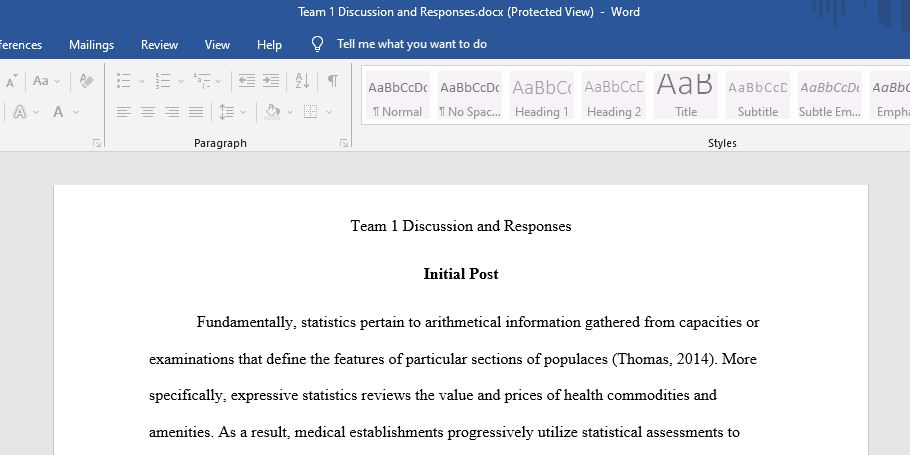Topic: Group Activity: Resolving Issues with Conflict Management
Course outcome assessed in this Discussion Assignment:
PC-1.3: Apply conflict management skills to resolve issues and/or build team alliances.
Break into two teams based on the first letter of your last name. There will be two response threads setup in this unit’s Discussion—one for each team.
Team 1 = A through M: Each member should argue that statistics add value to the health sciences.
Team 2 = N through Z: Each member should argue that statistics are used to mislead and confound issues.
The expectation of each team member is to fully support the team goals and objectives by contributing, as well as consistently assisting and/or supporting others in their contributions. The final post should be a collaborative effort (posted by one team member selected by the group) that resolves the viewpoints of both team 1 and team 2.
Remember:
You must contribute to the team goal of making an argument in favor of the team cause by posting a supportive thought, fact, or idea to strengthen the argument.
You must respond to at least two team members in a way that uses conflict resolution to help resolve the viewpoints of both teams.
The team objective is to resolve the differing viewpoints of each team into a stated position.
Grading: Half your grade will be based on the global Discussion Board grading rubric and half will be based on how well you support team goals and objectives through fulfilling your own contributions as well as consistently assisting and/or supporting others in their contributions.
Ackieve Derizzio
Investopedia defines statistics as a form of mathematical analysis that uses quantified models, representations and synopses for a given set of experimental data or real-life studies. It is a summarized version of information that is gather from studies, in mathematical form. People use it when the information is too large, or the area of study is too much to cover. It is analyzed and used to make informed decisions. What is health sciences? and what is it’s purpose? Public Health Online states that health science refers to a large group of disciplines related to the delivery of health care to humans and animals through the application of science, engineering, mathematics and technology. In other words, it is the field in which knowledge is taken from pure science and other related sources and applied to practical and clinical practices to maintain and improve the health of living beings. All these fields comes with large amounts of data, covers a wide range of topics, and reaches all the population. Statistics helps to summarize all this information, makes it easier to analyze, interpret and draw conclusions from. Without statistics, it would almost be impossible to gather and decipher all that information. Statistics is important to health sciences.
Reference
Grant, M. (2019). Statistics. Investopedia. Retrieved from https://www.investopedia.com/terms/s/statistics.asp
What is Health Science? (n.d.). Public Health Online. Retrieved from https://www.publichealthonline.org/health-sciences/#:~:text=Health%20science%20refers%20to%20a,%2C%20engineering%2C%20mathematics%20and%20technology.
Gerlinda Antoine
yesterday at 11:40 AM
Statistics add value to all aspects of health science. Anyone can make their point by stating random numbers and data that is not verified or checked with anyone. But having the data and research to back up what you are stating makes the research more credible. This shows that an effort was made, besides just an opinion to present facts on that specific topic. “By identifying statistical trends and trails, health care providers can monitor local conditions and compare them to state, national, and international trends. Health statistics provide empirical data to assist in the allocation of public and private funds and help to determine how research efforts should be focused. Whether considering disease incidence, accidents, cure rates, physician or hospital fees, malpractice, mortality, drugs, treatments, or medical devices, the primary source for statistical health data most often appears on government, international organization, or professional association web sites” (Bartkowiak 2004). Having statistical data also gives new researchers a platform to base future studies on. It also gives us a chance to evaluate the new statistics to see how much has changed over time or if things have changed. This is crucial in all aspects of health science.
Bartkowiak, B. A., & Finnegan, B. J. (2004). Health statistics. Clinical medicine & research, 2(3), 189–190. https://doi.org/10.3121/cmr.2.3.189
Answer preview:

word limit:591
